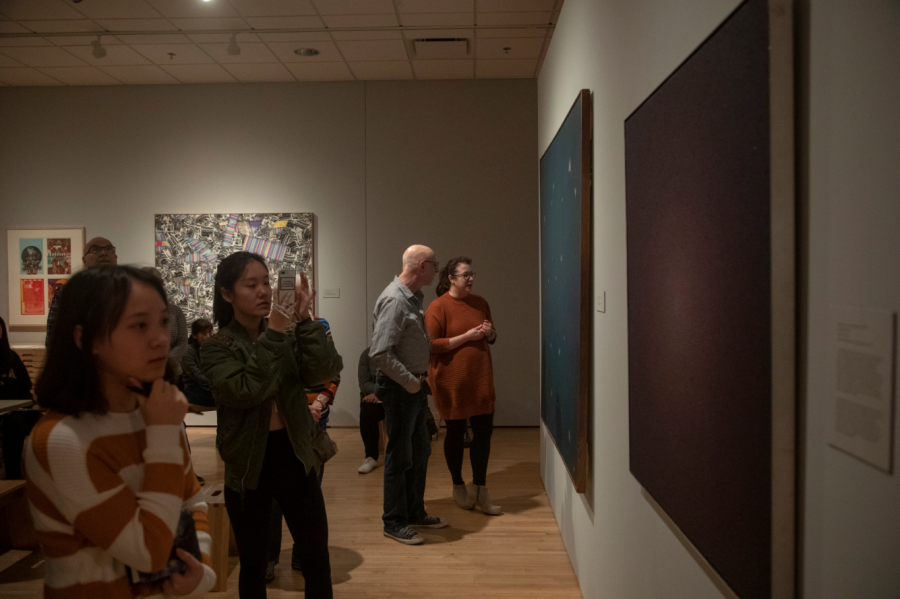Saturday at the Stanley: A practice in pointillism
UI Theater Department and UI Stanley Museum of Art partner to present a lecture about pointillism painter Georges Seurat.
Attendees observe artwork during a Pointillism workshop at the Stanley Art Museum on Saturday March 9. The event was a collaboration between the art and theater department.
March 10, 2019
A group of people stands in a small room, studying a painting. From far away, the painting seems to be of nothing in particular — just a solid purple-black canvas with a spotlight shown on it. But as the people step in closer, they notice that the painting consists of thousands of little colored dots, and the “spotlight” effect is created not by an actual light, but from the corona of colors spreading out from the center.
The technique is called pointillism, and it was made famous by artist Georges Seurat.
At 3 p.m. March 9, the University of Iowa Theater Department and UI Stanley Museum of Art partnered to present a lecture regarding Seurat’s short career and his profound impact on other artists. The lecture was designed to correspond with the UI theater production Sunday in the Park with George, which was performed this past weekend in Mabie Theater.
“Today, I’m going to talk to you about some of the works in our collection that have to do with Seurat’s technique, artists who were looking at similar subject matters and how they approached them,” Visiting Assistant Professor Kimberly Datchuk said. “His influence on thinking about color and how that creates a composition.”
She pointed to the purple corona painting as she said this and explained that Seaurat’s work and his pointillism technique inspired the artist of the piece, Sally Drummond.
RELATED: DITV: Staging the Painting
“Seurat was a neoimpressionist artist in France in the late-19th century,” Datchuk said. “He was interested in the way colors worked together. He didn’t use large parts of color, but instead used little dots of color and the juxtaposition of these dots to create an image. These polar colors, or complementary colors, and the juxtaposition of the colors created a really rich palette — a really luminous canvas.”
Sally Drummond’s Reinhardt, although seemingly simple, is a mastery of light and color.
“Subtle changes in gradation are used to create a luminosity in the canvas that makes it seem like there’s a bright spotlight in the canvas that it glows from within,” Datchuk said. “In the work that we have here, it has a subtle transition between blacks. She’s really playing with the idea of light and shadow and the meditative qualities what they can produce.”
Drummond’s mastery of color and light uses the pointillistic technique of placing colors next to each other to trick the eye into blending them together. The technique, most famous in Seurat’s A Sunday on La Grande Jatte, is what inspires the production Sunday in the Park with George
.
“Seurat’s painting is a large scene of people relaxing and enjoying their Sunday afternoon,” Datchuk said. “They’re enjoying the water, being in the sunlight, being in the shade. We have all different classes of people out there enjoying this.”
RELATED: A musical painted across time: Sunday in the Park with George
Seurat’s technique, made most famous with this piece, has paved the way for future pointillistic artists to harness light and luminosity through minuscule dots.
“This really unusual and wonderful tension between the clear distinction of all the figures creates a static scene,” Datchuk said. “The light, the way it plays off the colors makes the canvas shimmer. The way he uses whites is very unique. Seurat is really able to capture that luminosity, and the changes that happens in life. That fleeting beauty in the color white.”
Seurat’s work, as well as the play Sunday in the Park with George, invites viewers to step back and enjoy the subtleties — the little things in life — that can make a normal Sunday afternoon shimmer and glow with beauty.
“When you step back, there is a shadowed, volume effect within the people,” Datchuk said. “Seurat used peachy tones in the skin tones. He made realistic colored people. He’s trying to have a close relationship with what he’s seeing.”



